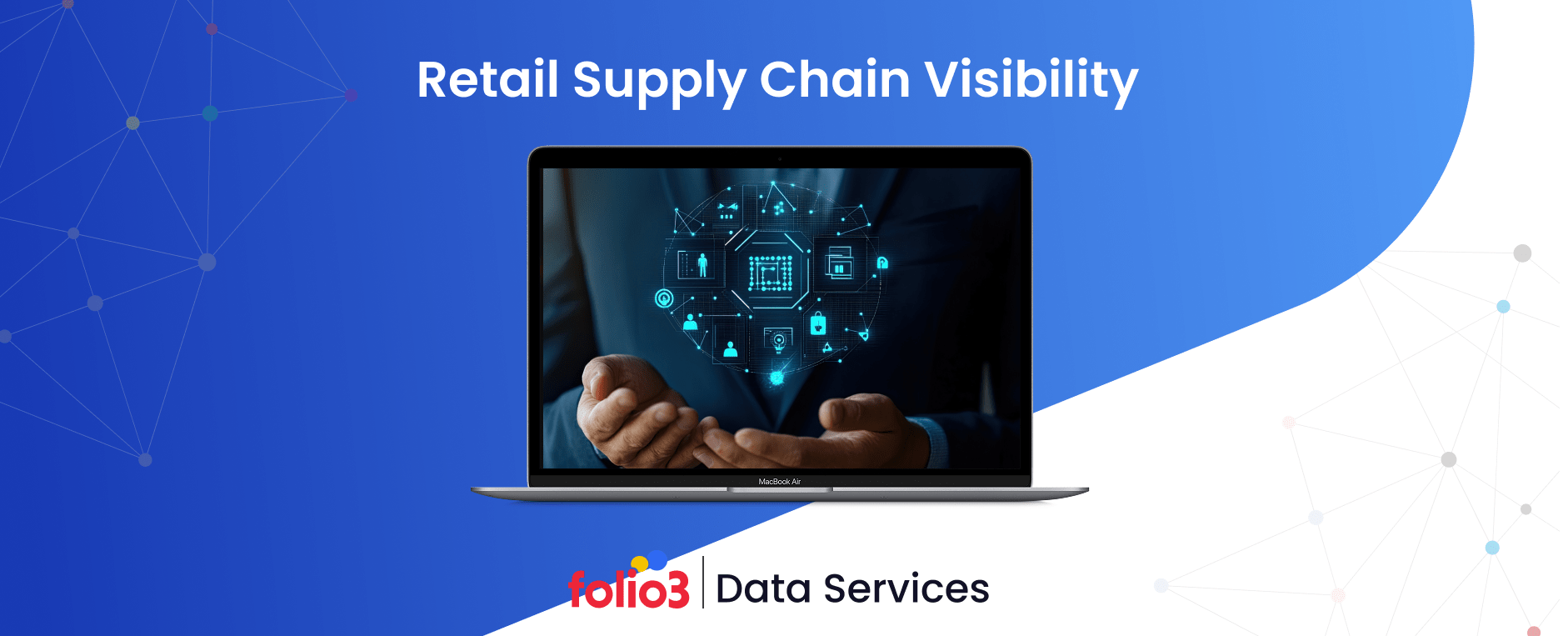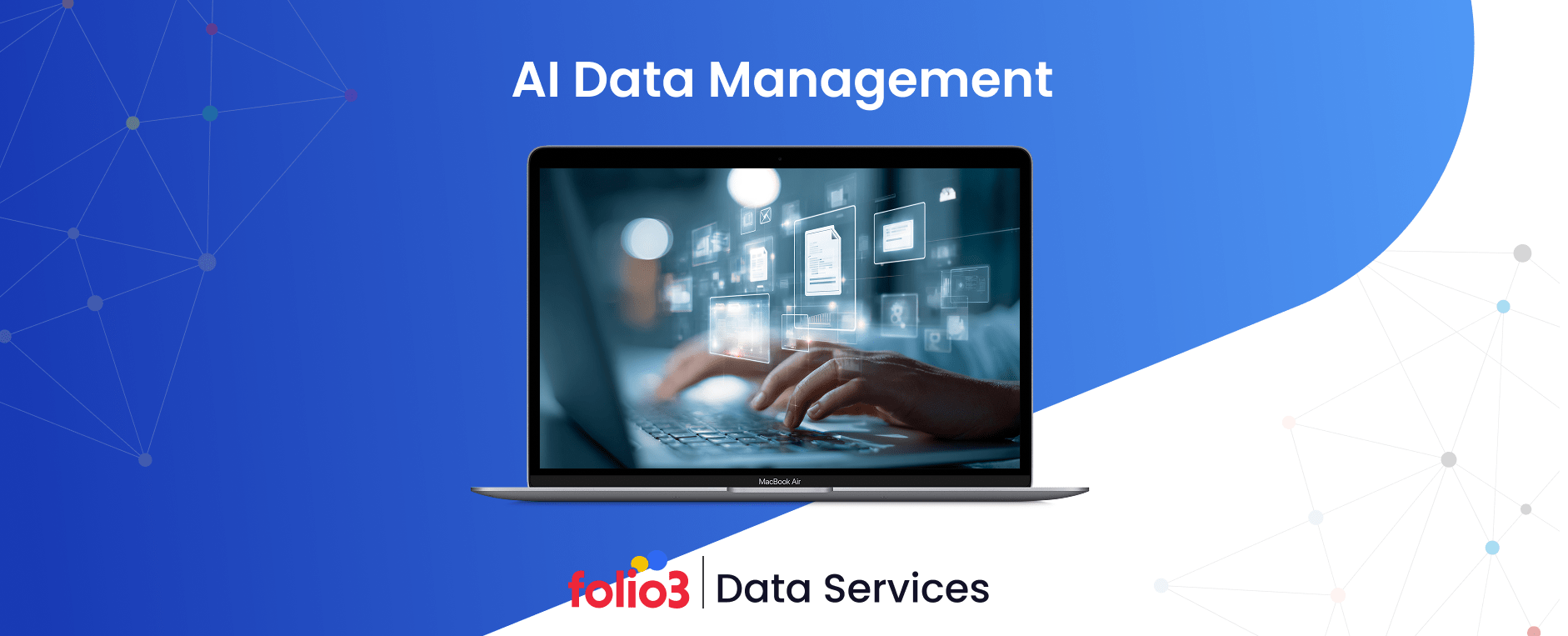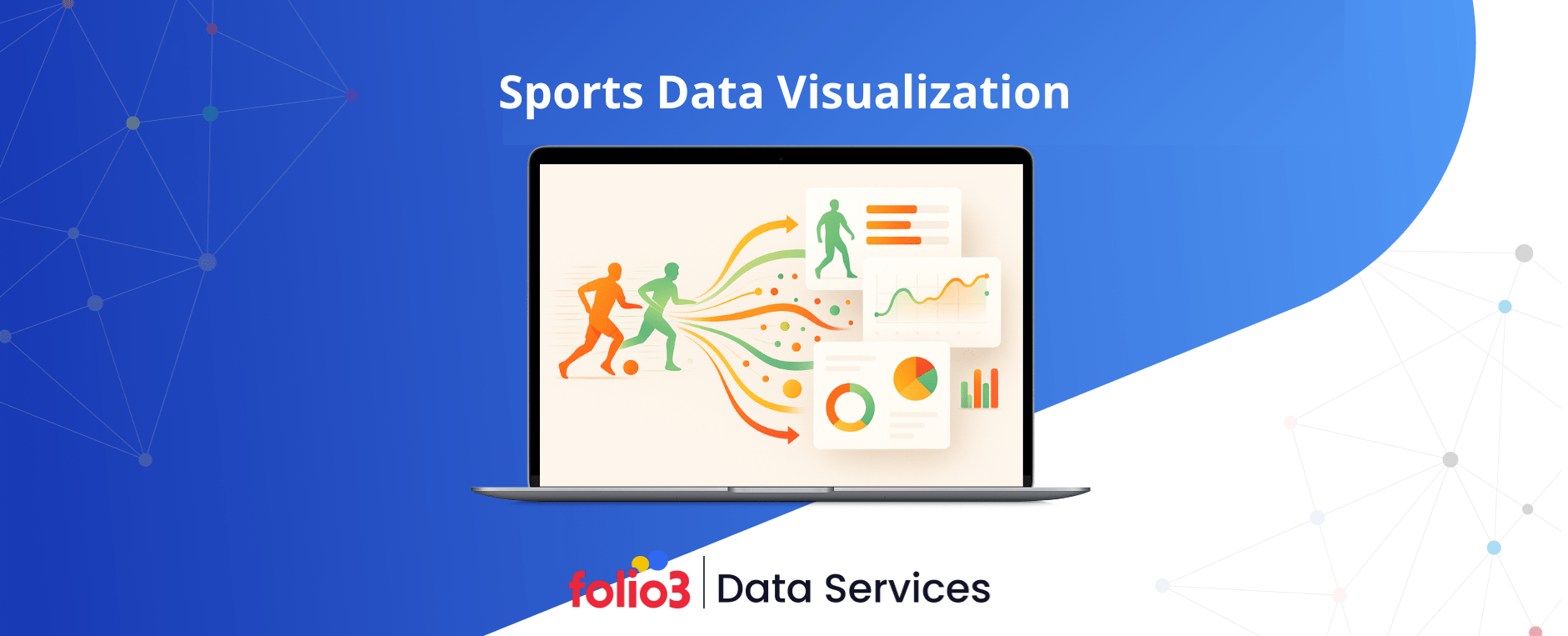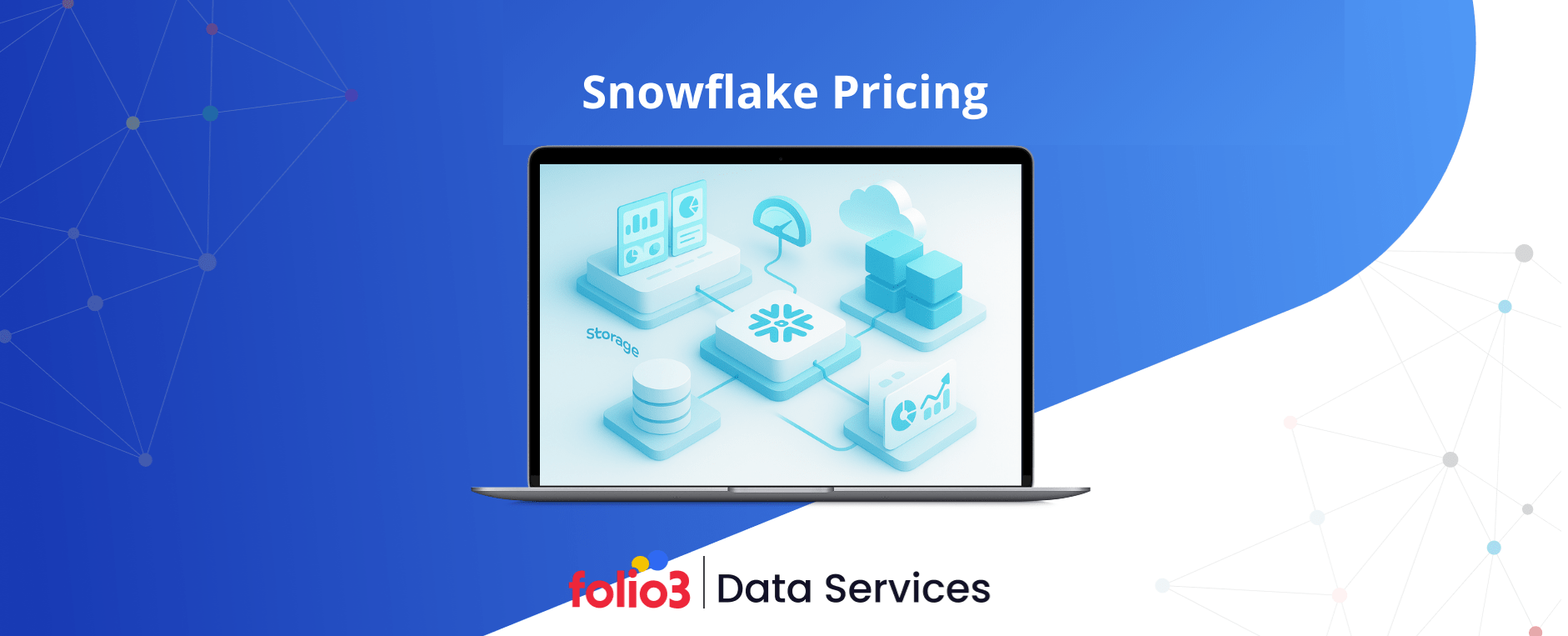Modern retail supply chains are no longer straightforward, linear networks. They are dynamic ecosystems connecting suppliers, warehouses, transportation providers, and customers across global markets. From sourcing raw materials to final delivery, a single product may pass through dozens of hands and data systems before reaching the end consumer.
This complexity creates blind spots that cost retailers billions each year in lost sales, excess inventory, and inefficient operations. Today’s shoppers expect Amazon-level service from every brand, with real-time updates, accurate delivery windows, and seamless order fulfillment.
At the same time, unexpected disruptions can upend entire distribution networks overnight. The difference between thriving and struggling retailers often comes down to one critical factor: visibility in the retail supply chain. Achieving strong supply chain visibility in retail requires more than tracking shipments.
It demands a connected infrastructure where every stakeholder shares accurate, real-time data. Retail supply chain data integration plays a pivotal role in creating transparency by linking warehouse management systems (WMS), enterprise resource planning (ERP) systems, supplier networks, and customer demand signals.
When retailers unify these data flows, they transform disconnected processes into a single source of truth, enabling smarter decision-making. In this blog, we’ll explore what retail supply chain visibility means, why it’s essential, and how modern technologies from AI to IoT are transforming retail operations into data-driven, customer-focused powerhouses.
What is Retail Supply Chain Visibility?
Retail supply chain visibility represents the ability to track, monitor, and understand every component of the supply chain in real-time, from raw materials to final delivery. This goes far beyond simply knowing where products are located. Accurate visibility encompasses inventory levels, supplier performance, transportation status, quality metrics, and demand signals, all integrated into a single, actionable view.
The concept has evolved significantly from traditional inventory tracking. Today’s supply chain visibility incorporates predictive analytics, automated alerts, and cross-functional dashboards, enabling proactive decision-making. It’s the difference between discovering a stockout when customers complain versus predicting it three weeks in advance and taking preventive action.
For retail organizations, this visibility translates into the ability to identify upstream supplier constraints that may impact product availability, understand downstream demand patterns that influence inventory planning, and access real-time operational metrics that inform daily decisions. The integration of warehouse management systems with broader supply chain data creates a unified view that spans from supplier factories to customer delivery.
Why Do Retailers Need Greater Supply Chain Visibility?
The evolving retail landscape demands visibility in the retail supply chain as a strategic necessity. With rising customer expectations, complex global networks, and intense competition, retailers can no longer rely on fragmented systems or delayed data.
A robust retail supply chain visibility strategy, driven by effective retail supply chain data integration, provides real-time insights, facilitates proactive decision-making, and yields measurable cost savings across every stage of operations. Here’s why retailers need greater supply chain visibility:
Optimize Inventory Management
Accurate inventory control is critical in balancing multi-channel sales, seasonal peaks, and unpredictable demand. Through retail supply chain data management, retailers can simultaneously track stock levels, incoming shipments, and supplier lead times.
With the help of big data in the retail industry, this level of supply chain visibility in retail helps reduce safety stock, prevent stockouts, and lower carrying costs while ensuring products remain available when and where customers need them.
Ensure Supplier Reliability
Global supplier networks introduce risks ranging from production delays to regulatory hurdles. Integrated systems and modern data integration techniques provide visibility into supplier performance, delivery schedules, and potential disruptions. Retailers can quickly identify alternative sourcing options, maintain continuity, and safeguard service levels during unexpected events.
Improve Collaboration & Data Sharing
Modern retail thrives on seamless collaboration between suppliers, logistics providers, and technology partners. Centralized platforms standardize data sharing, enabling enterprise data integration that allows suppliers to align production with real-time demand signals. This supply chain visibility retail approach strengthens partnerships and improves operational agility.
Control Freight and Logistics Costs
Transportation costs continue to rise due to fuel volatility and the increasing demand for fast delivery. By combining retail supply chain data integration with real-time shipment tracking, retailers can consolidate loads, optimize routing, and select carriers based on performance, reducing logistics expenses while maintaining delivery speed and reliability.
What Are the Benefits of Retail Supply Chain Visibility?
Implementing retail supply chain visibility delivers far-reaching advantages that strengthen operations, reduce costs, and improve customer satisfaction. With a well-structured retail supply chain visibility strategy supported by robust retail supply chain data integration, retailers gain real-time insights that drive smarter decisions and long-term competitiveness.
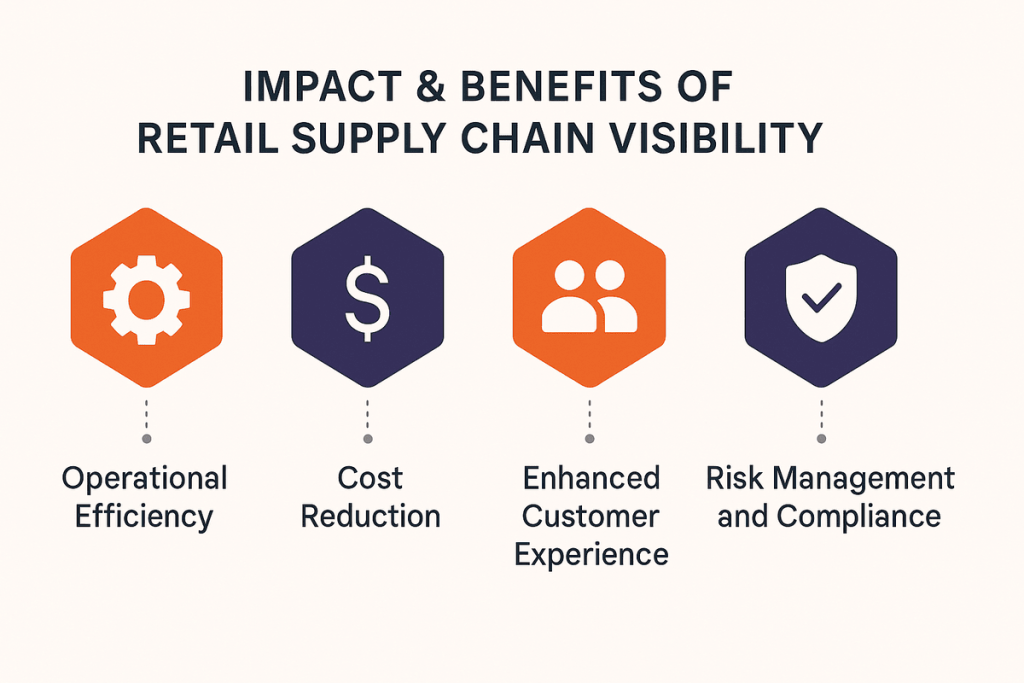
Operational Efficiency
Supply chain visibility in retail eliminates blind spots that cause delays and inefficiencies. By accessing real-time data on inventory, demand patterns, and supplier performance, retailers can coordinate procurement, warehousing, and distribution with precision and efficiency. This integration reduces manual processes, accelerates responses to disruptions, and typically improves operational efficiency by 10–15% within the first year.
Cost Reduction
A connected supply chain cuts costs across inventory, procurement, and transportation. Retail supply chain data management enables predictive planning, helping retailers avoid emergency sourcing or expedited shipping. Accurate performance data also strengthens supplier negotiations, reducing carrying costs and optimizing freight expenses.
Enhanced Customer Experience
Customer expectations for speed and accuracy demand seamless visibility. Real-time inventory updates enable accurate delivery timelines, proactive communication, and services like buy online, pick up in-store.
By leveraging unified retail customer data alongside retail supply chain data integration, retailers can provide consistent, personalized experiences across every channel, boosting satisfaction and loyalty.
Risk Management and Compliance
Modern supply chains face a range of risks, from regulatory demands to geopolitical challenges. Integrated visibility provides the traceability required for compliance in industries such as food, pharmaceuticals, and consumer goods. Retailers can identify supplier risks early, secure alternative sourcing, and maintain business continuity even during disruptions.
Why Do Retailers Struggle to Achieve True End-to-End Supply Chain Visibility?
Even with advanced tools and strategies, many retailers face significant barriers to achieving retail supply chain visibility. The combination of fragmented systems, inconsistent data, and organizational challenges makes it difficult to implement a seamless retail supply chain visibility strategy that connects every stakeholder.
Fragmented Systems and Data Silos
Retailers often operate across multiple ERP, WMS, and POS systems that have been built over years of growth and acquisitions. These platforms employ different data standards and rarely integrate smoothly, resulting in silos that hinder effective management of retail supply chain data.
External partners, suppliers, logistics providers, and carriers add more complexity with their own systems and formats. Legacy technologies lacking APIs or real-time capabilities further slow integration and limit retail supply chain data integration efforts.
Inaccurate or Delayed Data
Visibility is only as strong as the quality of the data feeding it. Manual data entry, inconsistent formats, and delayed updates result in outdated insights that fail to support real-time decision-making. Retailers must adopt strict data governance, automated capture, and quality monitoring to ensure reliable, timely information, forming the backbone of effective retail business intelligence.
Limited Supplier Collaboration
Many suppliers either lack modern technology or hesitate to share operational data due to competitive concerns. Without active supplier participation, even the best visibility platforms cannot deliver end-to-end transparency. Building trust and offering mutual value, such as shared forecasts or performance dashboards, is crucial for the success of supply chain visibility initiatives in the retail sector.
Technological, Resource, and Security Barriers
Implementing an advanced retail supply chain visibility strategy requires significant investment in cloud platforms, analytics tools, and skilled teams. Smaller retailers often struggle with costs, training, and change management.
Partnering with retail analytics consulting services can help bridge these gaps by providing the expertise and resources needed to design scalable solutions. At the same time, sharing sensitive supplier, pricing, and inventory data raises security and compliance risks, especially across international markets with varying regulations.
Connect systems, suppliers, and logistics to make faster, smarter retail decisions.
How Can Retailers Implement Retail Supply Chain Visibility?
Achieving retail supply chain visibility requires a structured, technology-driven strategy that addresses system gaps, supplier collaboration, and data management while delivering measurable business value. Retailers must focus on assessing existing infrastructure, defining clear KPIs, selecting the right technology, and fostering continuous improvement to ensure long-term success in their retail supply chain visibility strategy.
Assess Current Supply Chain Systems
The first step is a full audit of internal systems, external partner platforms, and data flows to identify gaps and integration challenges. Evaluating ERP, WMS, and logistics systems, along with supplier capabilities, lays the groundwork for realistic timelines and resource planning for retail supply chain data integration.
Define KPIs and Metrics
Straightforward, measurable KPIs guide implementation and track ROI. Metrics such as inventory turnover, supplier on-time performance, stockout rates, and order fulfillment provide actionable insights into supply chain efficiency. Establishing clear data governance in retail ensures that these metrics are accurate, consistent, and aligned across all systems and partners, supporting reliable decision-making.
Select the Right Technology Stack
Retailers should invest in scalable solutions that support supply chain data integration and real-time analytics. Cloud-based platforms offer flexibility, lower maintenance costs, and easier integration with partner systems, while also addressing compliance and data security needs.
Incorporating tools like AI enterprise search can further enhance visibility by allowing teams to quickly locate and analyze critical supply chain data across multiple sources. The stack should also include advanced analytics, mobile-friendly dashboards, and API-driven connectivity to existing ERP and WMS systems.
Integrate Suppliers and Partners
Supplier participation is critical for end-to-end supply chain visibility. Retailers can start by onboarding key suppliers with strong relationships and technical readiness. Integration methods may range from automated EDI connections to secure cloud portals, ensuring that smaller suppliers can also share their data in a timely manner. Offering value like shared forecasts or performance reports encourages broader collaboration.
Use Key Technologies
Cloud platforms enable scalable visibility in retail supply chains, while IoT sensors provide real-time data on product location and condition. AI-driven predictive analytics enhance retail demand forecasting, risk management, and inventory optimization, while blockchain ensures transparency and traceability for sensitive supply chains.
Continuous Monitoring and Improvement
Retail supply chain visibility is an ongoing process. Regular performance reviews, data quality audits, and user feedback help refine processes, expand supplier participation, and integrate emerging technologies. Partnering with experts in data integration consulting can further optimize these efforts, ensuring seamless connectivity and sustained competitive advantage.
Key Technologies Driving Retail Supply Chain Visibility
Modern retail supply chain visibility relies on an integrated technology stack that enables real-time data integration, predictive analytics, and secure collaboration across partners. The following technologies form the backbone of successful supply chain data integration strategies.
Cloud-Based Supply Chain Platforms
Cloud platforms provide the scalability, flexibility, and security needed for end-to-end supply chain visibility. They integrate diverse systems and suppliers, process large volumes of data in real-time, and offer advanced analytics and dashboards.
Platforms such as Databricks and Snowflake enable retailers to unify, process, and analyze data efficiently. Their SaaS model reduces upfront costs and ensures continuous updates, making it ideal for retailers seeking cost-effective solutions.
IoT and Sensor Technology
IoT devices such as RFID tags, GPS trackers, and temperature sensors deliver real-time data on inventory location, movement, and condition. This is critical for high-value goods, perishable products, and compliance-sensitive shipments, enabling proactive decisions before disruptions impact quality or delivery timelines.
AI and Predictive Analytics
Artificial intelligence transforms supply chain data into actionable insights for demand forecasting, supplier risk assessment, and inventory optimization. The use of predictive analytics in retail enables retailers to anticipate stockouts or delays, thereby shifting operations from reactive to proactive management.
Blockchain for Transparency
Blockchain creates tamper-proof transaction records, improving traceability and compliance. It fosters trust between retailers and suppliers by enabling secure, decentralized data sharing, which is essential for industries such as food, pharmaceuticals, and luxury goods.
ERP and WMS Integration
Smooth integration with ERP and warehouse management systems ensures real-time synchronization of inventory, supplier performance, and operational metrics. APIs enable continuous data exchange, allowing visibility into insights to drive automated decision-making and operational efficiency. Effective retail data engineering ensures that data pipelines are reliable, scalable, and optimized for actionable insights across the supply chain.
Best Practices for Improving Retail Supply Chain Visibility
Implementing retail supply chain visibility successfully requires a strategic approach that ensures accurate, real-time data sharing and collaboration across the entire network. Below are key best practices to strengthen supply chain data integration and improve operational performance.
Centralized Data Dashboards
Adopt centralized dashboards connected to a retail data warehouse to provide a single source of truth for inventory levels, supplier performance, and logistics status. Real-time visibility into key metrics enables faster decision-making and reduces disruptions across the retail supply chain.
Standardize Supplier Data
Establish consistent data formats and integration standards for all suppliers to ensure seamless data exchange. Standardization eliminates discrepancies, enhances data quality, and supports broader customer data integration efforts across systems and global partners.
Collaborative Supplier Relationships
Build strong, transparent partnerships with suppliers by encouraging data sharing and aligning goals. Collaborative relationships improve trust, enhance forecasting accuracy, and facilitate the more efficient addressing of challenges such as delays, shortages, or regulatory compliance.
Predictive Analytics Use
Use predictive analytics to forecast demand, identify risks, and optimize inventory levels. By transforming historical and real-time data into actionable insights, retailers can anticipate issues such as stockouts or supplier delays before they occur, while also enabling retail data monetization opportunities through the creation of new revenue streams from insights.
Regular Data Audits
Conduct regular data quality audits to ensure accuracy, completeness, and timeliness of data. Continuous monitoring helps identify integration gaps, prevent errors, and maintain the reliability of retail supply chain visibility tools.
Implement these best practices with Folio3 to achieve real-time visibility, optimize inventory, and strengthen supplier collaboration.
Retail Supply Chain Visibility vs. Other Approaches – Side-by-Side Comparison
Understanding how supply chain visibility compares to alternative approaches helps retailers make informed decisions about their supply chain strategy. This comparison reveals that while complete supply chain visibility necessitates a higher initial investment, it offers superior capabilities for risk management, scalability, and comprehensive visibility.
| Approach | Visibility Level | Implementation Cost | Time to Value | Scalability | Risk Management |
| Full Supply Chain Visibility | Comprehensive end-to-end view | High initial investment | 6-12 months | Highly scalable | Proactive risk identification |
| Traditional ERP Systems | Internal operations only | Moderate to high | 12-18 months | Limited by system architecture | Reactive responses |
| Supplier Portals | Limited to direct suppliers | Low to moderate | 3-6 months | Moderate scalability | Basic supplier monitoring |
| Manual Reporting | Minimal real-time visibility | Low technology cost | Immediate but limited | Not scalable | Crisis-driven responses |
| Point Solutions | Specific process areas | Variable by solution | 3-9 months | Limited integration | Fragmented risk view |
Real-World Success Stories in Retail Supply Chain Visibility
Walmart – Using Technology for Real-Time Inventory Insights
Walmart utilizes advanced retail supply chain visibility solutions to track inventory across its thousands of stores and distribution centers in real-time.
By integrating IoT sensors, predictive analytics techniques, and cloud-based analytics, Walmart can monitor stock levels, predict demand, and optimize replenishment. This strategy has reduced stockouts, improved on-shelf availability, and enhanced customer satisfaction. Source
Target – Enhancing Supplier Collaboration and Forecast Accuracy
Target improved its supply chain data integration by implementing predictive analytics and building stronger supplier relationships. By sharing real-time demand signals with suppliers through cloud data integration, Target reduced lead times and improved forecast accuracy, thereby maintaining consistent product availability during peak shopping seasons.
Regional Retailer – Scaling Visibility for Growth
Regional retailer Boxed adopted a cloud-based supply chain platform to achieve end-to-end visibility without heavy infrastructure costs. The solution integrated data from suppliers, logistics providers, and warehouses, enabling Boxed to respond faster to demand fluctuations and reduce inventory carrying costs. Source
Key Takeaways from These Success Stories
These examples demonstrate how leading and emerging retailers utilize supply chain visibility by integrating real-time data, employing predictive analytics, and fostering supplier collaboration. Whether it’s a global giant like Walmart or a growing regional brand, the ability to monitor inventory, forecast demand, and proactively manage disruptions drives operational efficiency and customer satisfaction.
Emerging Trends in Retail Supply Chain Visibility
The future of retail supply chain visibility is rapidly evolving as advanced technologies and market demands reshape how retailers track, analyze, and optimize their networks. Emerging trends focus on leveraging artificial intelligence, enhancing transparency, and meeting growing sustainability expectations.
AI-Driven Supply Chains
Artificial intelligence is enabling more autonomous supply chain management. Beyond predictive analytics, AI systems can now adjust inventory levels, reroute shipments, and modify supplier orders in real time.
Machine learning identifies complex demand patterns such as seasonal trends or competitive impacts, while AI data extraction ensures that vast amounts of unstructured supply chain information are transformed into actionable insights. Natural language processing also allows teams to query systems in everyday language for instant, data-driven decisions.
Blockchain for Sourcing
Blockchain is moving from pilot projects to practical applications, helping retailers verify sourcing practices, product authenticity, and sustainability claims. Smart contracts can automate compliance checks and payments, while immutable transaction records strengthen trust between retailers and suppliers.
Integrating predictive maintenance IoT data from supplier equipment can further ensure that production disruptions are minimized, enhancing reliability across the supply chain.
Digital Twin Simulations
Digital twins create virtual replicas of supply chain operations, enabling advanced scenario testing and network optimization. By integrating these simulations into a robust data integration architecture, retailers can model distribution center locations, inventory strategies, or supplier networks to predict outcomes before making costly changes. IoT sensor data makes these simulations increasingly accurate in real time.
Sustainability and ESG Focus
Growing environmental, social, and governance (ESG) requirements demand deeper visibility across multi-tier supplier networks. Blockchain and IoT sensors now track emissions, labor practices, and material sourcing, enabling retailers to meet compliance standards and satisfy eco-conscious consumers.
Generative AI for Forecasting
Generative AI for retail enhances demand forecasting by integrating external data sources such as social trends, weather patterns, and economic indicators while creating scenario-based projections. This helps retailers plan more accurately and manage risks in dynamic markets.
FAQs
1. What is retail supply chain visibility and why is it important?
Retail supply chain visibility is the ability to track products, inventory, and processes across the entire supply chain—from suppliers to end customers in real time. It’s essential for improving operational efficiency, reducing costs, and ensuring consistent product availability.
2. What are the main challenges in achieving supply chain visibility?
Key challenges include fragmented systems, data silos, inaccurate or delayed data, limited supplier collaboration, high technology costs, and compliance or security concerns across global networks.
3. What technologies enable retail supply chain visibility?
Cloud-based platforms, IoT sensors, AI and predictive analytics, blockchain, and integrations with ERP and WMS systems all play critical roles in achieving end-to-end visibility.
4. How can retailers improve supply chain visibility?
Retailers can centralize data dashboards, standardize supplier data, integrate partner systems, implement predictive analytics, and conduct regular data audits to ensure accurate, real-time insights.
5. What are the benefits of retail supply chain visibility?
Benefits include lower inventory costs, faster decision-making, improved supplier collaboration, enhanced customer experiences, and stronger risk management.
6. Can small or regional retailers achieve supply chain visibility?
Yes. Cloud-based SaaS platforms and scalable IoT solutions make visibility affordable and accessible for smaller retailers.
7. What are some real-world examples of retail supply chain visibility?
Walmart uses real-time analytics for inventory tracking, Target leverages supplier collaboration tools, and regional brands use cloud platforms for agile inventory management.
8. How does predictive analytics improve supply chain decision-making?
It forecasts demand, identifies potential disruptions, and recommends proactive actions to prevent stockouts or delays.
9. How can retailers measure the success of visibility initiatives?
Track KPIs such as inventory turnover, order fulfillment rates, supplier on-time delivery, and reductions in stockouts or excess inventory.
Conclusion
Retail supply chain visibility is no longer a competitive advantage but it’s a necessity for thriving in today’s fast-paced, omnichannel retail environment. By integrating cloud-based platforms, IoT sensors, predictive analytics, and real-time data sharing, retailers can reduce costs, improve operational efficiency, and deliver superior customer experiences.
A well-executed retail supply chain visibility strategy helps retailers to anticipate disruptions, optimize inventory, and strengthen supplier collaboration.
Partnering with Folio3 enables retailers to move beyond basic supply chain visibility through customized digital solutions that unify data, automate workflows, and enhance collaboration across the entire ecosystem.
With expertise in cloud integration, AI-driven analytics, and real-time monitoring, Folio3 helps retailers build resilient, agile supply chains that reduce risks, optimize inventory, and consistently deliver exceptional customer experiences.
